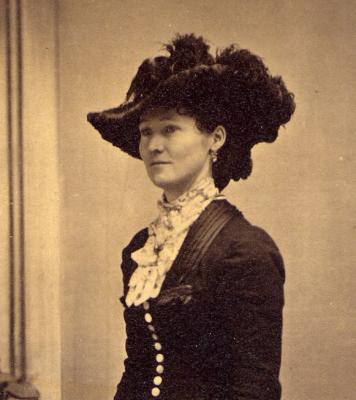Ladies and Their Hats
In my previous posting, I addressed what gentlemen should do with their hats. I will now briefly address the ladies, for whom the rules are altogether different.
 As with a gentleman, when a lady went outdoors, she wore a hat. It might be a practical hat or sensible bonnet, or it might not serve any conceivable purpose of protecting the wearer from the ravages of nature -- it might be little more than a tiny caricature of a hat, but it would be a hat.
As with a gentleman, when a lady went outdoors, she wore a hat. It might be a practical hat or sensible bonnet, or it might not serve any conceivable purpose of protecting the wearer from the ravages of nature -- it might be little more than a tiny caricature of a hat, but it would be a hat.
Unlike a gentleman however, etiquette did not demand that she remove it when meeting people or moving in and out of public and private spaces. Ladies' hats were often precisely pinned to their carefully composed coiffures, and removing them would cause all that painstaking work to collapse ignominiously - so in all social situations, etiquette never demanded that a lady remove her hat.
This was a centuries old understanding. Even back in the days when men were required to pluck their hats from their heads in the presence of their betters, no such requirement applied to women. A demure curtsy was always sufficient.
So, for example, if a lady were meeting friends for tea, she would put on her hat, go to the place were tea was to be had, and take tea with her hat on. An odd modern notion has arisen that somehow putting hats on was a requirement for the proper enjoyment of tea. This of course is nonsense. The hats would have been there whether the tea happened or not.
If a lady were entertaining in her own home, her guests would wear hats but she would not; though in the 19th Century she would almost certainly have worn some sort of linen or lace cap. It wasn't that naked hair was somehow scandalous, it was just that an adult Victorian lady did not feel like she was properly dressed without something on her head.
While etiquette did not demand that a lady remove her headgear, it also did not forbid it, and a lady might remove her hat or bonnet in a place where she felt comfortable, such as a friend's home. She could even remove it in a public place, providing it did not result in unsightly hat hair and she could do it effortlessly and did not subject strangers and acquaintances to the spectacle of her fussing with her "toilet" -- which was something that no proper lady would ever do.
In the late 19th Century, in the age of big hair and even bigger hats, theater owners started asking ladies to remove their hats so that people seated behind them might have some hope of seeing the show. As this went against centuries of custom, it occasioned some friction.
Ladies being asked to remove their hats was never a problem in the evening however, as a proper lady's evening ensemble, while it might include hair decorations and occasional plumage, never included a hat. A lady attending the opera or a ball would have no hat to remove.
So, as an organizer of historical dance events, I will finish with an exhortation to both men and women to come to the dance floor hatless. Historically, with the exception of the occasional "fancy dress" costume, hats in the ballroom simply wasn't done, and as you find your hat bumping into things and generally getting in the way, you may well understand why.
